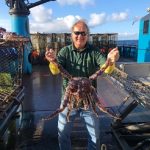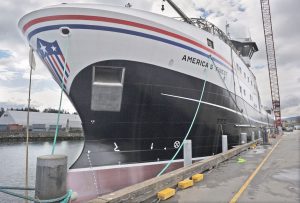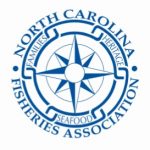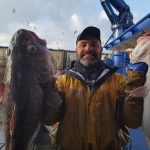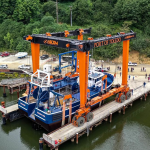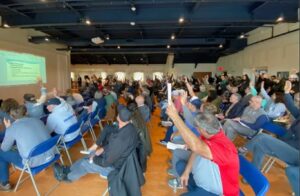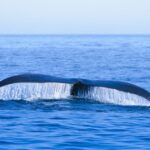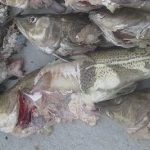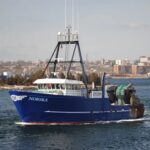Daily Archives: May 16, 2017
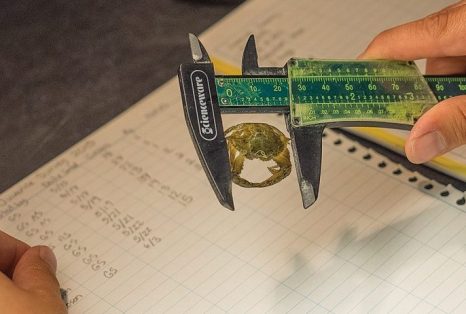
Fishery managers weighing cuts in Bay crab harvest
Chesapeake Bay crabbers will likely face some harvest restriction this season to protect future generations of the iconic crustacean, a move managers say is necessary because of the low population of juveniles. Fishery managers for Maryland, Virginia and the Potomac River Fisheries Commission all say they are considering shortening the season and imposing stricter limits on the harvest of female crabs. They are not proposing changes in male crab catches. News of harvest cuts surprised some crabbers at Maryland’s Blue Crab Industry Advisory Committee last week. The latest winter dredge survey results released in April showed the highest number of female crabs in the 28-year history of the annual count. Female crabs clocked in at 254 million, a 31 percent increase over last year. But the Baywide survey, which counts the crabs in more than 1,000 locations as they burrow in the mud, estimated there were 125 million juvenile crabs in the Chesapeake, a 54 percent decrease from the 271 million found in 2016. That is the lowest tally since 2013 — a year when crabbers also had their catch curtailed — and one of the five lowest estimates since 1990, managers said. Click here to continue reading the article 21:38
Tuna producers up to something fishy as they face conspiracy allegations
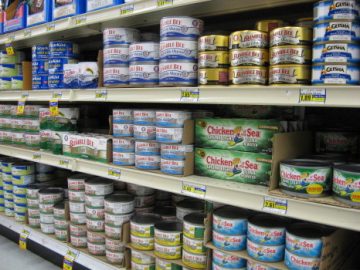 Executives of the most popular tuna brands in the U.S. — Chicken of the Sea, Bumble Bee and StarKist — conspired regularly to keep prices high for consumers with a taste for one of America’s favourite sandwich ingredients, according to criminal and civil court records updated this week. A typical can of tuna today costs about $1.50 and the U.S. Department of Justice says that price may be the result of price fixing by Thai, South Korean and U.S. seafood dealers, while major retailers are suing alleging they’ve been ripped off. The U.S. government began investigating criminal price fixing between the three companies more than two years ago. Together the companies supply about 80 per cent of the $1.7 billion of canned tuna sold annually in the United States, according to the court records. Following up, Walmart and other top retailers filed civil lawsuits. Click here to read the story 17:14
Executives of the most popular tuna brands in the U.S. — Chicken of the Sea, Bumble Bee and StarKist — conspired regularly to keep prices high for consumers with a taste for one of America’s favourite sandwich ingredients, according to criminal and civil court records updated this week. A typical can of tuna today costs about $1.50 and the U.S. Department of Justice says that price may be the result of price fixing by Thai, South Korean and U.S. seafood dealers, while major retailers are suing alleging they’ve been ripped off. The U.S. government began investigating criminal price fixing between the three companies more than two years ago. Together the companies supply about 80 per cent of the $1.7 billion of canned tuna sold annually in the United States, according to the court records. Following up, Walmart and other top retailers filed civil lawsuits. Click here to read the story 17:14
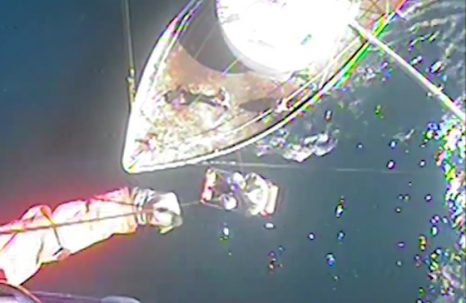
Coast Guard medevacs fisherman 50-miles off Atlantic City, N.J.
The Coast Guard medevacced a fisherman who was reportedly suffering stroke-like symptoms approximately 50-miles off the coast of New Jersey, Tuesday. Watchstanders at Coast Guard Sector Delaware Bay were notified that a fisherman aboard the 90-foot scallop boat Frank & Maria needed medical attention. An MH-65 Dolphin rescue helicopter crew was dispatched from Air Station Atlantic City and arrived on-scene and hoisted the man at approximately 8:40 a.m. Coast Guard rescuers brought the man to Atlanticare Regional Medical Center for medical attention. Click here for video 16:17

Shark Fin Trade Elimination Act – Shark fin bill hurts Americans, hinders shark conservation

Information Update #2: The Make Commercial Fishing Great Again Flotilla 2017
First, a hearty thank you to all who plan on attending this historic event! There has been some confusion by those who are still trying to label our gathering as a protest. They are wrong. What this gathering is all about is to show a sign of support to the graduating cadets’ from the fishing industry. We want this to make a positive impact! Also it’s a shout out to President Trump to take notice that our industry like so many others in our nation is under attack from over burdensome regulatory policies enacted by previous administrations. If anyone is interviewed by the media, PLEASE make these messages loud and clear. WE ARE NOT PROTESTING. We are : 1. Welcoming President Trump, 2. Congratulating the Coast Guard cadets, and 3. Asking the President for help to Make Commercial Fishing Great Again. It looks like the weather is going to be awesome. Summer like finally. We should all plan on gathering just south of the RT.95 bridge by 10AM. The commencement address by the President is scheduled for 11AM. We will have representatives on the scene at the event who we will be in contact with. We ask that everyone refrain from blowing horns until the ceremony is over. When we get word from the inside we can let loose with our salute! Again, thank you to all and we will be standing by on VHF Ch. 18 for coordination purposes. Enjoy your day on the water and be safe in your travels. 12:25
Cutting Deep – Commercial Fishermen killing one trout to save another in Yellowstone National Park
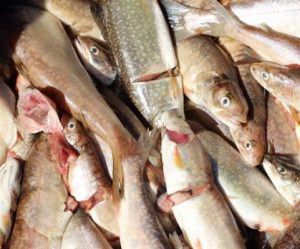 “Everything in Yellowstone National Park is a controversy,” says Dan Wenk, Yellowstone National Park superintendent. “And I’m glad it is because it means people care.” One of the things they care about is what’s going on in Yellowstone Lake. That’s where a commercial fishing crew from the Great Lakes region is catching lake trout with up to 40 miles of netting. This is the epicenter of the angry visitor’s angst. Lake trout are not native to the park. An angler caught the first one in 1994. By mid 2000s, lake trout had eaten 90 to 95 percent of the native Yellowstone cutthroat trout in the lake. Commercial gillnetting to kill lake trout went gangbusters in 2009. “The problem is lake trout are like large wolves on the landscape, only in the lake,” Koel says. “Large, highly predatory, fish-eating machines essentially.” Click here to read the story 12:01
“Everything in Yellowstone National Park is a controversy,” says Dan Wenk, Yellowstone National Park superintendent. “And I’m glad it is because it means people care.” One of the things they care about is what’s going on in Yellowstone Lake. That’s where a commercial fishing crew from the Great Lakes region is catching lake trout with up to 40 miles of netting. This is the epicenter of the angry visitor’s angst. Lake trout are not native to the park. An angler caught the first one in 1994. By mid 2000s, lake trout had eaten 90 to 95 percent of the native Yellowstone cutthroat trout in the lake. Commercial gillnetting to kill lake trout went gangbusters in 2009. “The problem is lake trout are like large wolves on the landscape, only in the lake,” Koel says. “Large, highly predatory, fish-eating machines essentially.” Click here to read the story 12:01
At Sea, Under the Eyes of Cameras
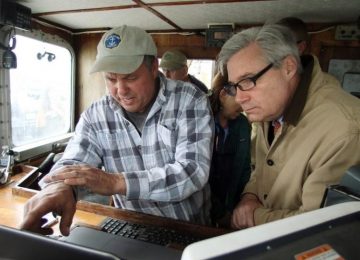 Chris Brown has grown used to the five video cameras that record every move he and his two crew members make aboard the Proud Mary. Since installing the equipment in January on the 45-foot otter trawler, whenever Brown steams out of Galilee in search of flounder and other groundfish in the Atlantic Ocean waters off Rhode Island, the electronic monitoring system kicks on. Brown is one of three Rhode Island fishermen who have signed on to a program that is testing out electronic surveillance as an alternative to human monitors that the federal government requires to be on board one in every seven fishing trips in the Northeast in an effort to stamp out overfishing. The new program being led by The Nature Conservancy offers the potential for closer observation of commercial fishing, enhancing compliance with quotas and deterring misreporting. But not everyone has embraced electronic monitoring. Click here to read the story 10:51
Chris Brown has grown used to the five video cameras that record every move he and his two crew members make aboard the Proud Mary. Since installing the equipment in January on the 45-foot otter trawler, whenever Brown steams out of Galilee in search of flounder and other groundfish in the Atlantic Ocean waters off Rhode Island, the electronic monitoring system kicks on. Brown is one of three Rhode Island fishermen who have signed on to a program that is testing out electronic surveillance as an alternative to human monitors that the federal government requires to be on board one in every seven fishing trips in the Northeast in an effort to stamp out overfishing. The new program being led by The Nature Conservancy offers the potential for closer observation of commercial fishing, enhancing compliance with quotas and deterring misreporting. But not everyone has embraced electronic monitoring. Click here to read the story 10:51
As I see It: More US action required on New England fishery – Congressman Raúl M. Grijalva
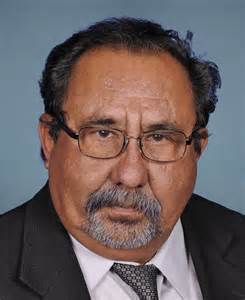 On March 30, Carlos Rafael – the infamous “Codfather” of New Bedford, Massachusetts – pleaded guilty to federal fraud charges.,,, His fraud in mislabeling nearly 800,000 pounds of fish to evade quotas on cod, flounder and sole was so massive that scientific studies using the misreported landings may have to be scrapped, adding additional uncertainty to a fishery that has been teetering on the edge of complete collapse for decades.,,, The Fisheries Service must also start saying ‘no’ to the New England Fishery Management Council, a regional regulatory body that includes many industry representatives.,,,It’s time to end the convenient and false narratives that blame science-based fisheries regulations and ocean conservation initiatives, such as the Northeast Canyons and Seamounts Marine National Monument on the edge of the continental shelf off Cape Cod, for problems they did not create. Click here to read the op-ed 09:41
On March 30, Carlos Rafael – the infamous “Codfather” of New Bedford, Massachusetts – pleaded guilty to federal fraud charges.,,, His fraud in mislabeling nearly 800,000 pounds of fish to evade quotas on cod, flounder and sole was so massive that scientific studies using the misreported landings may have to be scrapped, adding additional uncertainty to a fishery that has been teetering on the edge of complete collapse for decades.,,, The Fisheries Service must also start saying ‘no’ to the New England Fishery Management Council, a regional regulatory body that includes many industry representatives.,,,It’s time to end the convenient and false narratives that blame science-based fisheries regulations and ocean conservation initiatives, such as the Northeast Canyons and Seamounts Marine National Monument on the edge of the continental shelf off Cape Cod, for problems they did not create. Click here to read the op-ed 09:41
Southeast Alaska winter troll catch falls short of limit, Spring troll fishery underway
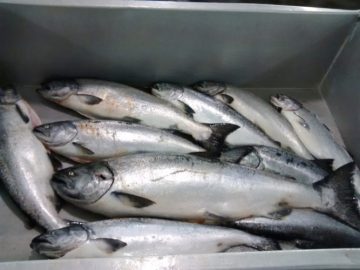 The preliminary harvest total is just over 43,000 kings. Most of those, around 40,000, are fish managed under the Pacific Salmon Treaty between the U.S. and Canada. Those fish mostly come from hatcheries in Canada and the Pacific coast of the U.S. The rest come from hatcheries in Southeast Alaska. The last two years the winter season has ended early as the fleet has surpassed a 45,000 fish guideline harvest level, or GHL, for Treaty kings. “So a down year,” said Grant Hagerman, the Alaska Department of Fish and Game’s troll management biologist for Southeast.,, Last year the season ended in record time, closing March 8. This year fishing remained open for the full season, through the end of April. Both catch rates and effort picked up in the final weeks of the season. Click here to read the story 08:46
The preliminary harvest total is just over 43,000 kings. Most of those, around 40,000, are fish managed under the Pacific Salmon Treaty between the U.S. and Canada. Those fish mostly come from hatcheries in Canada and the Pacific coast of the U.S. The rest come from hatcheries in Southeast Alaska. The last two years the winter season has ended early as the fleet has surpassed a 45,000 fish guideline harvest level, or GHL, for Treaty kings. “So a down year,” said Grant Hagerman, the Alaska Department of Fish and Game’s troll management biologist for Southeast.,, Last year the season ended in record time, closing March 8. This year fishing remained open for the full season, through the end of April. Both catch rates and effort picked up in the final weeks of the season. Click here to read the story 08:46


































